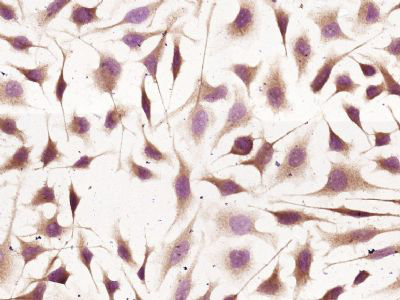产品货号 : mlR11055
英文名称 : Laminin alpha 4
中文名称 : 层粘蛋白α4抗体
别 名 : LAMA3; LAMA4 1; LAMA4; LAMA4_HUMAN; Laminin alpha 4; Laminin alpha 4 chain; Laminin subunit alpha 4 precursor; Laminin subunit alpha-4; Laminin-14 subunit alpha; Laminin-8 subunit alpha; Laminin-9 subunit alpha; Lamininα4; Laminin α4; Laminin-α4; Laminin α 4.
研究领域 : 肿瘤 神经生物学 信号转导 细胞粘附分子 细胞外基质
抗体来源 : Rabbit
克隆类型 : Polyclonal
交叉反应 : Human, Mouse, Rat, Dog, Cow, Horse, Rabbit, Sheep,
产品应用 : ELISA=1:500-1000 IHC-P=1:400-800 IHC-F=1:400-800 ICC=1:100-500 IF=1:100-500 (石蜡切片需做抗原修复)
not yet tested in other applications.
optimal dilutions/concentrations should be determined by the end user.
分 子 量 : 200kDa
细胞定位 : 细胞膜 细胞外基质 分泌型蛋白
性 状 : Lyophilized or Liquid
浓 度 : 1mg/ml
免 疫 原 : KLH conjugated synthetic peptide derived from human Laminin alpha 4:901-1000/1823
亚 型 : IgG
纯化方法 : affinity purified by Protein A
储 存 液 : 0.01M TBS(pH7.4) with 1% BSA, 0.03% Proclin300 and 50% Glycerol.
保存条件 : Store at -20 °C for one year. Avoid repeated freeze/thaw cycles. The lyophilized antibody is stable at room temperature for at least one month and for greater than a year when kept at -20°C. When reconstituted in sterile pH 7.4 0.01M PBS or diluent of antibody the antibody is stable for at least two weeks at 2-4 °C.
PubMed : PubMed
产品介绍 : Laminins are essential and abundant structural non-collagenous glyco- proteins localizing to basement membranes. Basement membranes (cell-associated extracellular matrices (ECMs)) are polymers of laminins with stabilizing Type IV collagen networks, Nidogen, and several proteoglycans. Basement membranes are found under epithelial layers, around the endothelium of blood vessels, and surrounding muscle, peripheral nerve, and fat cells. Formation of basement membranes influences cell proliferation, phenotype, migration, gene expression, and tissue architecture. Each laminin is a heterotrimer of a, b, and g chain subunits that undergoes cell-secretion and incorporation into the ECM. Laminins can self-assemble, bind to other matrix macromolecules, and have unique and shared cell interactions mediated by integrins, dystroglycan, and cognate laminin receptors. The human Laminin a-4 gene maps to chromosome 6q21 and is expressed in adult heart, lung, ovary, small and large intestines, liver, and placenta.
Function:
Binding to cells via a high affinity receptor, laminin is thought to mediate the attachment, migration and organization of cells into tissues during embryonic development by interacting with other extracellular matrix components.
Subunit:
Laminin is a complex glycoprotein, consisting of three different polypeptide chains (alpha, beta, gamma), which are bound to each other by disulfide bonds into a cross-shaped molecule comprising one long and three short arms with globules at each end. Alpha-4 is a subunit of laminin-8 (laminin-411), laminin-9 (laminin-421) and laminin-14 (laminin-423).
Subcellular Location:
Secreted > extracellular space > extracellular matrix > basement membrane. Major component.
Tissue Specificity:
In adult, strong expression in heart, lung, ovary small and large intestines, placenta, liver; weak or no expression in skeletal muscle, kidney, pancreas, testis, prostate, brain. High expression in fetal lung and kidney. Expression in fetal and newborn tissues is observed in certain mesenchymal cells in tissues such as smooth muscle and dermis.
Similarity:
Contains 4 laminin EGF-like domains.
Contains 5 laminin G-like domains.
SWISS:
Q16363
Gene ID:
3910
Important Note:
This product as supplied is intended for research use only, not for use in human, therapeutic or diagnostic applications.
产品图片












